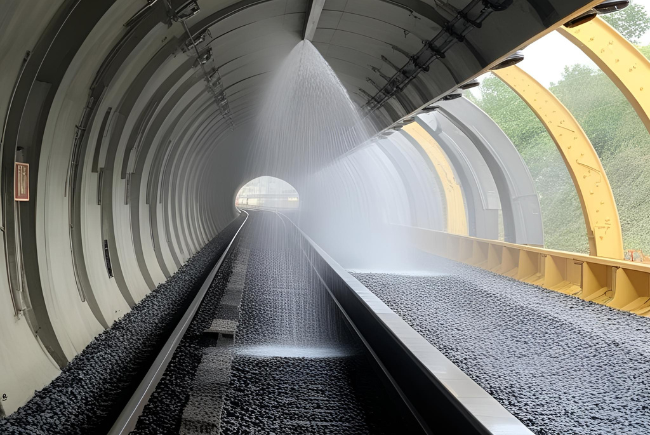Fire Suppression & Protection Solutions for Railway Tunnels
Railway tunnels and train carriages present unique fire safety challenges due to their confined spaces, high passenger volumes, and limited escape routes. A reliable fire suppression system is not just a regulatory requirement it’s essential for protecting lives, infrastructure, and operational continuity. This guide explores why fire suppression is crucial in railway tunnels and trains, how it works, which systems are most effective, and where they should be installed.
Synergy Fire provide custom-engineered fire suppression solutions that ensure rapid fire detection, automatic suppression, and enhanced passenger safety, ensuring compliance with international railway safety standards.
Why Fire Suppression is Critical in Railway Tunnels?

Limited Access for Firefighters
Emergency response is challenging due to long tunnel distances and restricted entry points.

Rapid Fire & Smoke Spread
Tunnels trap heat and smoke, allowing fires to spread faster than in open spaces.

High Electrical & Fuel-Related Fire Risks
Railway tunnels contain high-voltage power lines, control panels, and fuel-powered trains, increasing fire risks.

Infrastructure & Service Disruptions
Fires can damage tunnel walls, train tracks, and ventilation systems, leading to costly repairs and train delays.
How These Fire Suppression Systems Work
Water Mist Systems

- Utilizes high-pressure nozzles to discharge ultra-fine water droplets.
- The droplets absorb heat quickly, lowering the temperature and suppressing flames.
- The mist also displaces oxygen locally, which helps in suffocating the fire.
- Installed in tunnel ceilings, train compartments, and equipment rooms.
- Activates automatically via smoke or heat detectors. Can be zoned for targeted response, minimizing unnecessary water spread.
- Best Used For: Tunnel ceilings/walls, Passenger areas, Cable trays, Mixed-use compartments
- Rapid cooling.
- Minimal water damage suitable for electronics and interiors.
Clean Agent Systems

- Stored as liquid, discharged as a gas when a fire is detected.
- Suppresses fire by interrupting the chemical chain reaction (not by cooling).
- Safe for people and non-damaging to sensitive electronics.
- Installed in electrical cabinets, control panels, and engine compartments inside trains.
- Integrated with detection systems (e.g., heat, smoke).
- Releases quickly (within seconds) to protect high-value assets.
- Best Used For: Control rooms, Power cabinets, Driver cabs, Electrical cabinets
- Leaves no residue no clean up required.
- Excellent for enclosed spaces.
Aerosol Fire Suppression

- Contains a solid chemical compound that, when triggered, releases a fire-suppressing aerosol cloud.
- Aerosol particles interrupt combustion reactions, stopping the fire without displacing oxygen.
- Ideal for small or enclosed spaces, such as engine rooms, battery banks, and HVAC compartments.
- Easily installed in older trains due to compact size.
- Best Used For: Engine compartments, Battery enclosure, Space-limited retrofits
- Minimal space required.
- Works even in power outage scenarios.
Linear Heat Detection + Sprinkler Integration

- Linear Heat Detection (LHD) uses a heat-sensitive cable that runs continuously along tunnels or compartments.
- This cable detects temperature rises at any point along its length, even in harsh or dusty environments.
- Once the temperature exceeds a preset threshold, it triggers the fire alarm system.
- The system then activates sprinkler heads or water mist nozzles only in the affected zone, providing targeted suppression.
- Installed along tunnel walls, ceilings, or under train carriages.
- Integrated with water mist, foam, or clean agent systems to localize the response.
- Provides real-time alerts to operators or control rooms.
- Best Used For:Long railway tunnels (passenger or freight routes).
- Early detection even in hard-to-reach areas.
- Enables zoned fire suppression for faster control and safety.
How Do Fire Suppression Systems Work?
Inside Tunnels:
Detection - Smoke and heat detectors trigger alerts.
Activation - Based on fire class, the system (water mist or foam) activates automatically.
Suppression - Fire is suppressed, temperature is reduced, and smoke is pushed out via ventilation systems.
Evacuation Support - Alarms, lights, and ventilation help people escape safely.
Inside Trains:
Embedded Sensors detect abnormal temperature or smoke.
Localized Suppression engages in affected compartments (engine, passenger cabin, battery areas).
Control System communicates alerts to driver and command center.
Where Should Fire Suppression Systems Be Installed?
In Railway Tunnels:
Every 50–100 meters along tunnel walls for full coverage.
Tunnel ceiling and escape routes, to manage overhead fires.
Ventilation and power supply shafts high-risk components.
Inside Trains:
Driver cabins and control rooms.
Passenger compartments, especially those carrying luggage or batteries.
Electrical cabinets, battery storage, and HVAC systems.
Engine compartments, braking systems, and undercarriage areas.
Application-Based Recommendations for Railway Systems
| Area | Recommended Solution |
|---|---|
| Tunnel Infrastructure | Water Mist + Linear Heat Detection |
| Train Engine Compartment | Clean Agent or Aerosol System |
| Passenger Cabin | Water Mist or Compact Aerosol Units |
| Battery/Electrical Room | Clean Agent (e.g., Novec 1230) |
| Maintenance Areas | Foam Suppression Systems |
Products
Watermist / CAFS System
Click Here
Fire Suppression System
Click Here
Novec 1230 Fire Suppression Systems
Click Here
Why Choose Synergy Fire?
Railway-specific expertise
Certified, compliant systems
Advanced detection & suppression
Compact & retrofit-friendly designs
Proven track record in critical industries
End-to-end service & support
Protect Railway Tunnels with Advanced Fire Protection Systems!
Railway tunnels need high-performance fire suppression and protection to prevent major fire disasters and ensure passenger safety.
Contact Synergy Fire today for a custom railway tunnel fire suppression solution!